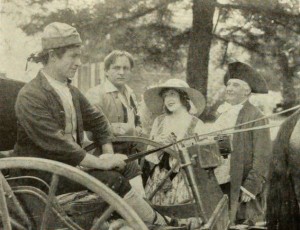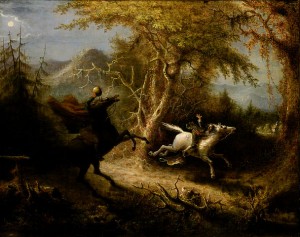American writer Washington Irving published The Legend of Sleepy Hollow in 1820. It’s a spooky tale of murky possibilities. A perfect story for Halloween.
The story begins in 1790 in an area near Tarrytown, New York that is called Sleepy Hollow. The hollow had a reputation for enchantment and the appearance of unusual apparitions, the most famous of whom was the ghost of a Hessian trooper whose head had been blown off by a cannon ball during the Revolutionary War. He was buried in the nearby Old Dutch Burying Ground. This Headless Horseman rode forth every night in search of his head, but he had to be back in his grave by daybreak.
We leave this luckless specter to consider the schoolmaster Ichabod Crane. In appearance, “he was tall, but exceedingly lank, with narrow shoulders, long arms and legs, hands that dangled a mile out of his sleeves, feet that might have served for shovels, and his whole frame most loosely hung together. His head was small, and flat at top, with huge ears, large green glassy eyes, and a long snipe nose, so that it looked like a weather-cock perched upon his spindle neck to tell which way the wind blew.”
Ichabod was also a credulous individual with an appetite “for the marvelous, and his powers of digesting it, were equally extraordinary … No tale was too gross or monstrous for his capacious swallow.”

Ichabod wanted to marry Katrina Van Tassel, the only child of a wealthy Dutch farmer. Aside from her financial attractions, Katrina “was a blooming lass of fresh eighteen; plump as a partridge; ripe and melting and rosy-cheeked as one of her father’s peaches.” She was also a flirt, and among her other suitors was Brom Van Brunt, a young man of considerable prowess. The countryside “rang with his feats of strength and hardihood. He was broad-shouldered and double-jointed, with short curly black hair, and a bluff but not unpleasant countenance, having a mingled air of fun and arrogance.”
Ichabod didn’t give up his suit, but kept things low key to avoid a direct conflict with his rival.
One evening Ichabod was invited to a party at Katrina’s house. He took extra care with his appearance and borrowed a horse. “The animal he bestrode was a broken-down plow-horse, that had outlived almost everything but its viciousness. He was gaunt and shagged, with a ewe neck, and a head like a hammer; his rusty mane and tail were tangled and knotted with burs; one eye had lost its pupil, and was glaring and spectral, but the other had the gleam of a genuine devil in it.”
Ichabod rode with short stirrups that brought his knees up to the saddle pommel. He carried his whip like a scepter, “and as his horse jogged on, the motion of his arms was not unlike the flapping of a pair of wings.”
Nevermind. It was an excellent party with good food, plenty to drink, dancing, and the telling of ghost stories, especially the tale of a man named Brouwer who encountered the Headless Horseman. The ghost chased Brouwer until they reached a bridge where the ghost turned into a skeleton and disappeared in a clap of thunder. Brom revealed that he himself had raced the Hessian on the wager of a bowl of punch and would have won. But when they reached the bridge, the Headless Horseman disappeared in a flash of fire.
Ichabod drank in every word.
Before leaving, Ichabod had a quiet word with the lovely Katrina. Apparently the interview did not end well, because when Ichabod left he “stole forth with the air of one who had been sacking a hen roost, rather than a fair lady’s heart,” got on his horse and dejectedly went on his way.

Soon Ichabod was surrounded by darkness. He reached the stream by Wiley’s Swamp where he beheld shadow of something huge. Ichabod urged his horse into a gallop. The shadow matched his gate. Ichabod increased his speed. So did the shadow.
“On mounting a rising ground, which brought the figure of his fellow-traveller in relief against the sky, gigantic in height, and muffled in a cloak, Ichabod was horror-struck on perceiving that he was headless!—but his horror was still more increased on observing that the head, which should have rested on his shoulders, was carried before him on the pommel of his saddle!”
Ichabod’s desperate race continued until he saw the bridge where he might lose his tormentor. He reached the other side, and turned to see the horseman standing in his stirrups. The monster threw his head directly in Ichabod’s face.
The next day, Ichabod’s horse was found at home eating grass. There was no sign of Ichabod. A search found the saddle, a smashed pumpkin, and Ichabod’s hat. After considering the information, townsmen concluded the Headless Horseman had carried off the schoolteacher to an unknown destination, and thought no more about it.
Acknowledgements:
Featured Image: “Ichabod Crane Pursued by Headless Horseman.” by F. O. C. Darley. 1849. US Public Domain. Wikimedia Commons.
All pictures in the US Public Domain and accessed at Wikimedia Commons.
Quotations taken from The Legend of Sleepy Hollow. Gutenberg Project. Read the entire story Here.

Sandra Wagner-Wright holds the doctoral degree in history and taught women’s and global history at the University of Hawai`i. Sandra travels for her research, most recently to Salem, Massachusetts, the setting of her new Salem Stories series. She also enjoys traveling for new experiences. Recent trips include Antarctica and a river cruise on the Rhine from Amsterdam to Basel.
Sandra particularly likes writing about strong women who make a difference. She lives in Hilo, Hawai`i with her family and writes a blog relating to history, travel, and the idiosyncrasies of life.

